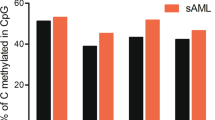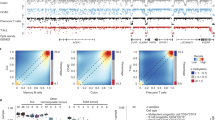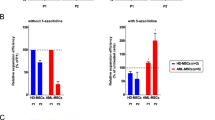Abstract
Gene expression profiling signatures may be used to classify the subtypes of Myelodysplastic syndrome (MDS) patients. However, there are few reports on the global methylation status in MDS. The integration of genome-wide epigenetic regulatory marks with gene expression levels would provide additional information regarding the biological differences between MDS and healthy controls. Gene expression and methylation status were measured using high-density microarrays. A total of 552 differentially methylated CpG loci were identified as being present in low-risk MDS; hypermethylated genes were more frequent than hypomethylated genes. In addition, mRNA expression profiling identified 1005 genes that significantly differed between low-risk MDS and the control group. Integrative analysis of the epigenetic and expression profiles revealed that 66.7% of the hypermethylated genes were underexpressed in low-risk MDS cases. Gene network analysis revealed molecular mechanisms associated with the low-risk MDS group, including altered apoptosis pathways. The two key apoptotic genes BCL2 and ETS1 were identified as silenced genes. In addition, the immune response and micro RNA biogenesis were affected by the hypermethylation and underexpression of IL27RA and DICER1. Our integrative analysis revealed that aberrant epigenetic regulation is a hallmark of low-risk MDS patients and could have a central role in these diseases.
This is a preview of subscription content, access via your institution
Access options
Subscribe to this journal
Receive 12 print issues and online access
$259.00 per year
only $21.58 per issue
Buy this article
- Purchase on Springer Link
- Instant access to full article PDF
Prices may be subject to local taxes which are calculated during checkout




Similar content being viewed by others
References
Cazzola M, Malcovati L . Myelodysplastic syndromes--coping with ineffective hematopoiesis. N Engl J Med 2005; 352: 536–538.
Vardiman JW, Thiele J, Arber DA, Brunning RD, Borowitz MJ, Porwit A et al. The 2008 revision of the World Health Organization (WHO) classification of myeloid neoplasms and acute leukemia: rationale and important changes. Blood 2009; 114: 937–951.
Nolte F, Hofmann WK . Myelodysplastic syndromes: molecular pathogenesis and genomic changes. Ann Hematol 2008; 87: 777–795.
Herman JG, Baylin SB . Gene silencing in cancer in association with promoter hypermethylation. N Engl J Med 2003; 349: 2042–2054.
Esteller M . Epigenetics in cancer. N Engl J Med 2008; 358: 1148–1159.
Jenuwein T, Allis CD . Translating the histone code. Science 2001; 293: 1074–1080.
Brinkman AB, Pennings SW, Braliou GG, Rietveld LE, Stunnenberg HG . DNA methylation immediately adjacent to active histone marking does not silence transcription. Nucleic Acids Res 2007; 35: 801–811.
Figueroa ME, Reimers M, Thompson RF, Ye K, Li Y, Selzer RR et al. An integrative genomic and epigenomic approach for the study of transcriptional regulation. PLoS One 2008; 3: e1882.
Jones PA, Laird PW . Cancer epigenetics comes of age. Nat Genet 1999; 21: 163–167.
Esteller M, Fraga MF, Paz MF, Campo E, Colomer D, Novo FJ et al. Cancer epigenetics and methylation. Science 2002; 297: 1807–1808.
Jones PA, Baylin SB . The epigenomics of cancer. Cell 2007; 128: 683–692.
Bennett LB, Schnabel JL, Kelchen JM, Taylor KH, Guo J, Arthur GL et al. DNA hypermethylation accompanied by transcriptional repression in follicular lymphoma. Genes Chromosomes Cancer 2009; 48: 828–841.
Mills KI, Kohlmann A, Williams PM, Wieczorek L, Liu WM, Li R et al. Microarray-based classifiers and prognosis models identify subgroups with distinct clinical outcomes and high risk of AML transformation of myelodysplastic syndrome. Blood 2009; 114: 1063–1072.
Theilgaard-Monch K, Boultwood J, Ferrari S, Giannopoulos K, Hernandez-Rivas JM, Kohlmann A et al. Gene expression profiling in MDS and AML: potential and future avenues. Leukemia 2011; 25: 909–920.
Sridhar K, Ross DT, Tibshirani R, Butte AJ, Greenberg PL . Relationship of differential gene expression profiles in CD34+ myelodysplastic syndrome marrow cells to disease subtype and progression. Blood 2009; 114: 4847–4858.
Shen L, Kantarjian H, Guo Y, Lin E, Shan J, Huang X et al. DNA methylation predicts survival and response to therapy in patients with myelodysplastic syndromes. J Clin Oncol 2010; 28: 605–613.
Estecio MR, Yan PS, Ibrahim AE, Tellez CS, Shen L, Huang TH et al. High-throughput methylation profiling by MCA coupled to CpG island microarray. Genome Res 2007; 17: 1529–1536.
Haferlach T, Kohlmann A, Wieczorek L, Basso G, Kronnie GT, Bene MC et al. Clinical utility of microarray-based gene expression profiling in the diagnosis and subclassification of leukemia: report from the International Microarray Innovations in Leukemia Study Group. J Clin Oncol 2010; 28: 2529–2537.
Risueno A, Fontanillo C, Dinger ME, De Las RJ . GATExplorer: genomic and transcriptomic explorer; mapping expression probes to gene loci, transcripts, exons and ncRNAs. BMC Bioinformatics 2010; 11: 221.
Irizarry RA, Bolstad BM, Collin F, Cope LM, Hobbs B, Speed TP . Summaries of Affymetrix GeneChip probe level data. Nucleic Acids Res 2003; 31: e15.
Tusher VG, Tibshirani R, Chu G . Significance analysis of microarrays applied to the ionizing radiation response. Proc Natl Acad Sci USA 2001; 98: 5116–5121.
Altschul SF, Madden TL, Schaffer AA, Zhang J, Zhang Z, Miller W et al. Gapped BLAST and PSI-BLAST: a new generation of protein database search programs. Nucleic Acids Res 1997; 25: 3389–3402.
Frommer M, McDonald LE, Millar DS, Collis CM, Watt F, Grigg GW et al. A genomic sequencing protocol that yields a positive display of 5-methylcytosine residues in individual DNA strands. Proc Natl Acad Sci USA 1992; 89: 1827–1831.
Huang dW, Sherman BT, Tan Q, Kir J, Liu D, Bryant D et al. DAVID Bioinformatics Resources: expanded annotation database and novel algorithms to better extract biology from large gene lists. Nucleic Acids Res 2007; 35: W169–W175.
Ho Sui SJ, Mortimer JR, Arenillas DJ, Brumm J, Walsh CJ, Kennedy BP et al. oPOSSUM: identification of over-represented transcription factor binding sites in co-expressed genes. Nucleic Acids Res 2005; 33: 3154–3164.
Kielbasa SM, Klein H, Roider HG, Vingron M, Bluthgen N . TransFind–predicting transcriptional regulators for gene sets. Nucleic Acids Res 2010; 38: W275–W280.
Zambelli F, Pesole G, Pavesi G . Pscan: finding over-represented transcription factor binding site motifs in sequences from co-regulated or co-expressed genes. Nucleic Acids Res 2009; 37: W247–W252.
Tonon L, Touzet H, Varre JS . TFM-Explorer: mining cis-regulatory regions in genomes. Nucleic Acids Res 2010; 38: W286–W292.
Galm O, Herman JG, Baylin SB . The fundamental role of epigenetics in hematopoietic malignancies. Blood Rev 2006; 20: 1–13.
Martin-Subero JI, Ammerpohl O, Bibikova M, Wickham-Garcia E, Agirre X, Alvarez S et al. A comprehensive microarray-based DNA methylation study of 367 hematological neoplasms. PLoS One 2009; 4: e6986.
Pellagatti A, Cazzola M, Giagounidis AA, Malcovati L, Porta MG, Killick S et al. Gene expression profiles of CD34+ cells in myelodysplastic syndromes: involvement of interferon-stimulated genes and correlation to FAB subtype and karyotype. Blood 2006; 108: 337–345.
Ramirez JM, Schaad O, Durual S, Cossali D, Docquier M, Beris P et al. Growth differentiation factor 15 production is necessary for normal erythroid differentiation and is increased in refractory anaemia with ring-sideroblasts 4. Br J Haematol 2009; 144: 251–262.
Pellagatti A, Cazzola M, Giagounidis A, Perry J, Malcovati L, la Porta MG et al. Deregulated gene expression pathways in myelodysplastic syndrome hematopoietic stem cells. Leukemia 2010; 24: 756–764.
Vasikova A, Budinska E, Belickova M, Cermak J, Bruchova H . Differential gene expression of bone marrow CD34+ cells in early and advanced myelodysplastic syndrome. Neoplasma 2009; 56: 335–342.
Parker JE, Mufti GJ . The role of apoptosis in the pathogenesis of the myelodysplastic syndromes. Int J Hematol 2001; 73: 416–428.
Carvalho JR, Filipe L, Costa VL, Ribeiro FR, Martins AT, Teixeira MR et al. Detailed analysis of expression and promoter methylation status of apoptosis-related genes in prostate cancer. Apoptosis 2010; 15: 956–965.
Friedrich MG, Weisenberger DJ, Cheng JC, Chandrasoma S, Siegmund KD, Gonzalgo ML et al. Detection of methylated apoptosis-associated genes in urine sediments of bladder cancer patients. Clin Cancer Res 2004; 10: 7457–7465.
Kang GH, Lee S, Cho NY, Gandamihardja T, Long TI, Weisenberger DJ et al. DNA methylation profiles of gastric carcinoma characterized by quantitative DNA methylation analysis. Lab Invest 2008; 88: 161–170.
Ito Y, Miyoshi E, Takeda T, Sakon M, Noda K, Tsujimoto M et al. Expression and possible role of ets-1 in hepatocellular carcinoma. Am J Clin Pathol 2000; 114: 719–725.
Fisher RJ, Mavrothalassitis G, Kondoh A, Papas TS, High-affinity DNA . protein interactions of the cellular ETS1 protein: the determination of the ETS binding motif. Oncogene 1991; 6: 2249–2254.
Seth A, Watson DK . ETS transcription factors and their emerging roles in human cancer. Eur J Cancer 2005; 41: 2462–2478.
Arora S, Kaur J, Sharma C, Mathur M, Bahadur S, Shukla NK et al. Stromelysin 3, Ets-1, and vascular endothelial growth factor expression in oral precancerous and cancerous lesions: correlation with microvessel density, progression, and prognosis. Clin Cancer Res 2005; 11: 2272–2284.
Buggy Y, Maguire TM, McGreal G, McDermott E, Hill AD, O'Higgins N et al. Overexpression of the Ets-1 transcription factor in human breast cancer. Br J Cancer 2004; 91: 1308–1315.
Span PN, Manders P, Heuvel JJ, Thomas CM, Bosch RR, Beex LV et al. Expression of the transcription factor Ets-1 is an independent prognostic marker for relapse-free survival in breast cancer. Oncogene 2002; 21: 8506–8509.
Kim EK, Kang JY, Rho YH, Kim YS, Kim DS, Bae YS . Silencing of the CKII alpha and CKII alpha' genes during cellular senescence is mediated by DNA methylation. Gene 2009; 431: 55–60.
Reuther GW . JAK2 activation in myeloproliferative neoplasms: a potential role for heterodimeric receptors. Cell Cycle 2008; 7: 714–719.
Batten M, Ghilardi N . The biology and therapeutic potential of interleukin 27 4. J Mol Med 2007; 85: 661–672.
Raaijmakers MH, Mukherjee S, Guo S, Zhang S, Kobayashi T, Schoonmaker JA et al. Bone progenitor dysfunction induces myelodysplasia and secondary leukaemia. Nature 2010; 464: 852–857.
Zighelboim I, Reinhart AJ, Gao F, Schmidt AP, Mutch DG, Thaker PH et al. DICER1 expression and outcomes in endometrioid endometrial adenocarcinoma. Cancer 2011; 117: 1446–1453.
Baylin SB, Herman JG . DNA hypermethylation in tumorigenesis: epigenetics joins genetics. Trends Genet 2000; 16: 168–174.
Ehrlich M . DNA methylation in cancer: too much, but also too little. Oncogene 2002; 21: 5400–5413.
Acknowledgements
This study was partially supported by grants from the Spanish Fondo de Investigaciones Sanitarias FIS 09/01543, Proyectos de Investigación del SACYL 355/A/09, COST Action ‘EuGESMA’ (BM0801), Northern Ireland Leukemia Research Fund (NILRF), Northern Ireland Assembly Department of Education and Learning, Obra Social Banca Cívica (Caja Burgos), and by the ‘Acción Transversal del Cáncer’ project, through an agreement between the Instituto de Salud Carlos III (ISCIII), Spanish Ministry of Science and Innovation, the Cancer Research Foundation of Salamanca University and the Redes de Investigación RTIIC (FIS). MdR is fully supported by an "Ayuda Predoctoral’ by the Fundación Española de Hematología y Hemoterapia. We thank Irene Rodríguez, Sara González, Teresa Prieto, Ma Ángeles Ramos, Almudena Martín, Ana Díaz, Ana Simón, María del Pozo and Vanesa Gutiérrez of the Centro de Investigación del Cáncer, Salamanca, Spain and Anne Carson from the Centre for Cancer Research and Cell Biology, Belfast, UK, for their technical assistance.
Author information
Authors and Affiliations
Corresponding author
Ethics declarations
Competing interests
The authors declare no conflict of interest.
Additional information
Supplementary Information accompanies the paper on the Leukemia website
Rights and permissions
About this article
Cite this article
del Rey, M., O'Hagan, K., Dellett, M. et al. Genome-wide profiling of methylation identifies novel targets with aberrant hypermethylation and reduced expression in low-risk myelodysplastic syndromes. Leukemia 27, 610–618 (2013). https://doi.org/10.1038/leu.2012.253
Received:
Revised:
Accepted:
Published:
Issue Date:
DOI: https://doi.org/10.1038/leu.2012.253
Keywords
This article is cited by
-
Fetal hemoglobin level predicts lower-risk myelodysplastic syndrome
International Journal of Hematology (2023)
-
Genome-wide transcriptomics leads to the identification of deregulated genes after deferasirox therapy in low-risk MDS patients
The Pharmacogenomics Journal (2020)
-
Epigenetic therapy of myelodysplastic syndromes connects to cellular differentiation independently of endogenous retroelement derepression
Genome Medicine (2019)
-
Genetic and epigenetic analysis of the BAX and BCL2 in the placenta of pregnant women complicated by preeclampsia
Apoptosis (2019)
-
Molecular characterization of EZH2 mutant patients with myelodysplastic/myeloproliferative neoplasms
Leukemia (2017)



